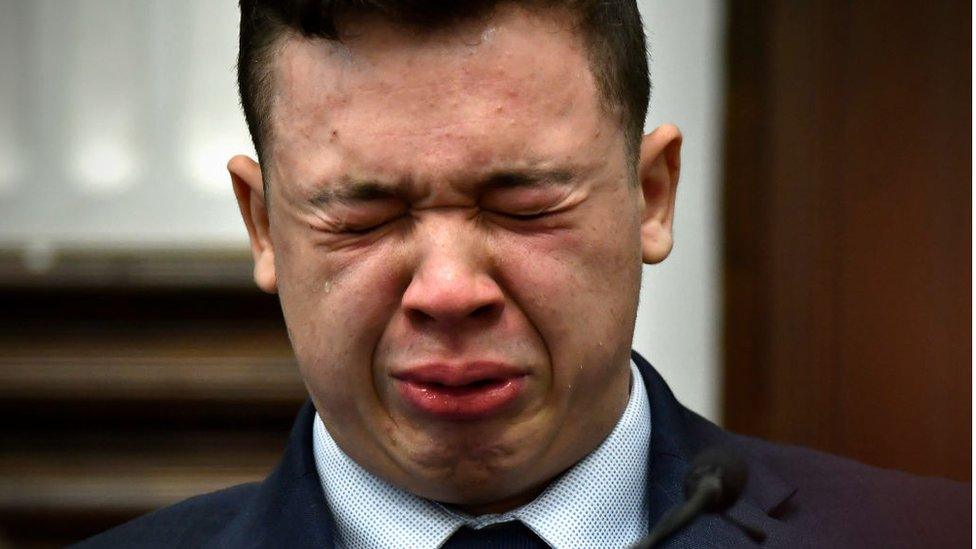Kyle Rittenhouse: Accused teen takes stand in his own defence
- Published

Kyle Rittenhouse broke into tears on the stand as he testified in his own defence
A US teenager charged with shooting three people during civil unrest on the streets of Wisconsin last year has taken the stand in his own defence.
Kyle Rittenhouse broke down in tears, forcing a brief recess, as he described how he was "cornered" by several men and acted in self-defence.
Prosecutors say Mr Rittenhouse, 18, was looking for trouble that night.
The teen has pleaded not guilty to all charges against him.
But the entire case was thrown into jeopardy on Wednesday when the defence called for a mistrial after the judge angrily accused the prosecution of improper questions to the defendant.
Mr Rittenhouse is facing counts of reckless, intentional and attempted homicide after he shot two men dead and wounded another in the city of Kenosha on 25 August 2020.
Riots had erupted on the streets of the city two days earlier, after police shot a black man, Jacob Blake. Mr Rittenhouse had travelled to the city from his home in Illinois and, with a semi-automatic rifle in tow, he said he sought to help protect property from unrest on the streets.
What did he say about the killings?
Taking the stand in a risky move for any defendant in a murder trial, Mr Rittenhouse said: "I didn't do anything wrong. I defended myself."
Describing scenes of chaos to the jury, he said he had heard people shouting "get him".
Video evidence shows the gun-toting teen shouting out "friendly, friendly, friendly" to the crowd.
"The person that attacked me first threatened to kill me," he said of Joseph Rosenbaum, the first person he shot. He told the jury he believed Mr Rosenbaum was carrying a chain with him at one point, though he later learned it was a plastic bag.
The judge called for a break after Mr Rittenhouse burst into tears as he began to describe to the jury the moments before the fatal shootings. His mother was also seen sobbing in the gallery.
Upon his return to the stand, the teen said he had nowhere to run at the time, later adding: "I didn't intend to kill. I intended to stop the person who was trying to kill me and trying to steal my gun."
Mr Rittenhouse said he shot and killed Mr Rosenbaum after Mr Rosenbaum laid a hand on his rifle.
Video from the scene shows the teen fall to the ground as he is chased. Mr Rittenhouse said it led him to fear for his life even more, as several men converged upon him.
He testified that Anthony Huber, the second person shot by Mr Rittenhouse, hit him with his skateboard and also tried to grab his rifle.
He said Gaige Grosskreutz, the man he wounded in the arm, had approached him with a pistol pointed at his head.
Mr Grosskreutz, the third person to be shot by Mr Rittenhouse, testified this week he thought Mr Rittenhouse was an "active shooter" when he drew his own gun and advanced on him.
"I brought the gun for protection but I didn't think I would have to use the gun in defending myself," Mr Rittenhouse responded.
How did prosecutors question him?
Prosecutors argue that Mr Rittenhouse inserted himself into the situation and intended to kill everyone he shot that evening.
In a testy cross-examination, prosecutor Thomas Binger contested the teen's right to possess a rifle and sought to cast doubt on the extent of his medical training.
Mr Binger - the assistant district attorney of Kenosha - also questioned the sincerity of Mr Rittenhouse's tears, making specific reference to a social media post in which Mr Rittenhouse said he was "just trying to be famous" and photos prosecutors say show him posing with far-right provocateurs.
But Mr Binger's line of questioning drew several furious reprimands from Judge Bruce Schroeder, who accused him of violating pre-trial rulings on introducing evidence not relevant to the trial.
"You're an experienced trial lawyer," yelled the judge. "I don't know what you're up to."
The legal teams continued to butt heads into the afternoon, as prosecutors continued to raise issues with Mr Rittenhouse's testimony and accused him of changing his story to fit a narrative.
How did the mistrial motion come up?
Defence attorneys argued "prosecutorial overreaching" and called for a mistrial with prejudice.
A successful motion for mistrial with prejudice cannot be appealed by prosecutors.
Judge Schroeder did not rule on the motion on Wednesday, but agreed to take it "under advisement" based on the future behaviour of the prosecution team.
Lead attorney Corey Chirafasi even suggested that prosecutors may have been angling for the mistrial because the case was "going badly" for them.
What was Mr Rittenhouse doing in Kenosha?
Mr Rittenhouse said on the stand he was in town because he had seen the destruction caused by the unrest. In particular, he mentioned seeing on social media that a police officer had a brick thrown at his head.
He detailed how he had joined up with other armed civilians to protect a series of local car dealerships, adding the owner "was happy we were there".
Before the shootings, Mr Rittenhouse claimed, he provided medical assistance to at least two people. He said he had worked as a firefighter and first responder cadet in his hometown, so he was able to administer first aid and basic emergency care.
He also testified that he and others had been moving around to put out fires and clean up graffiti.
The state rested its case on Tuesday. Mr Rittenhouse is the third witness on the stand for the defence and his testimony may be pivotal in deciding his fate.
Related topics
- Published9 November 2021
